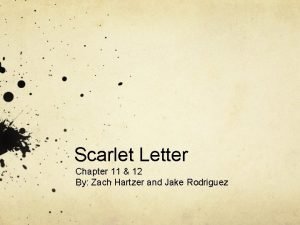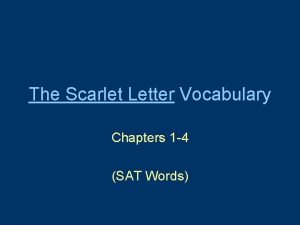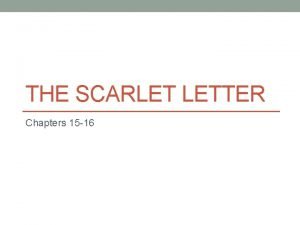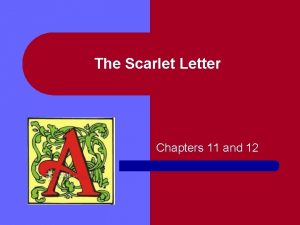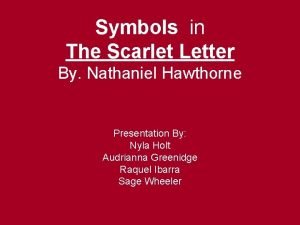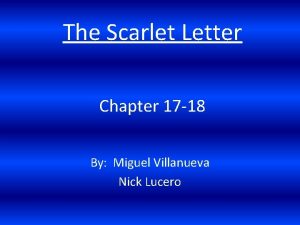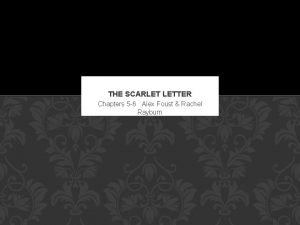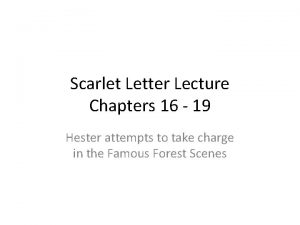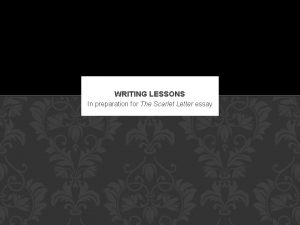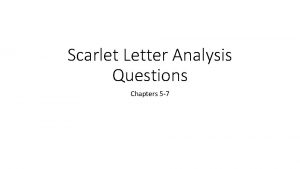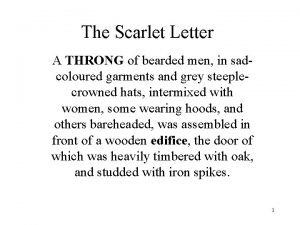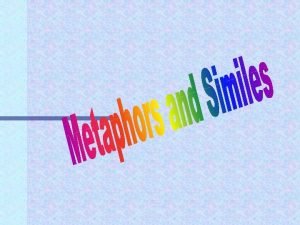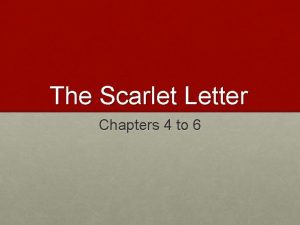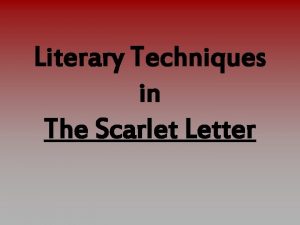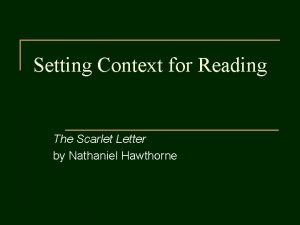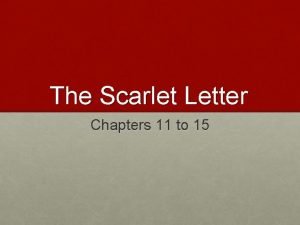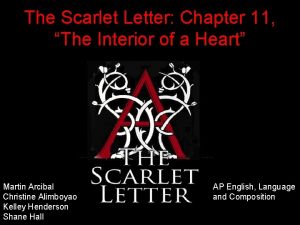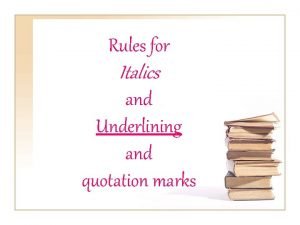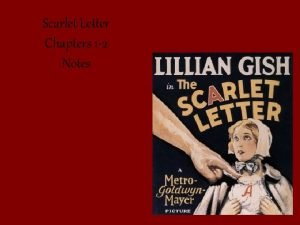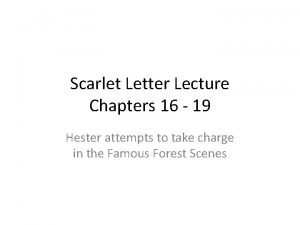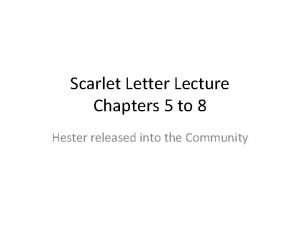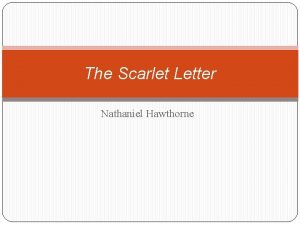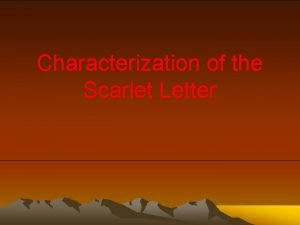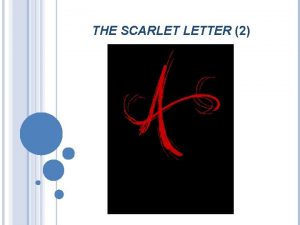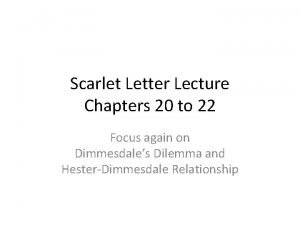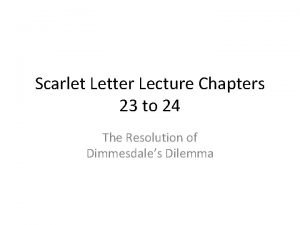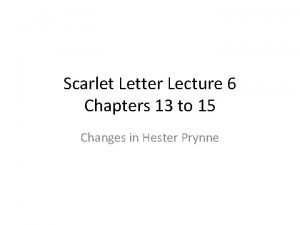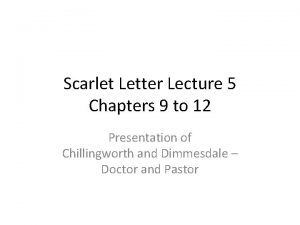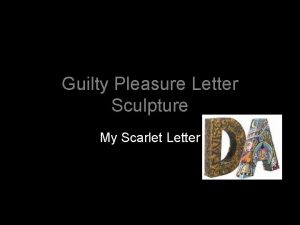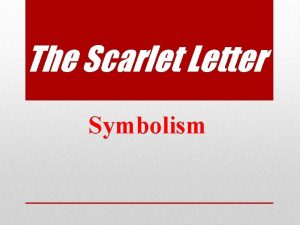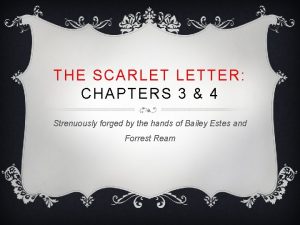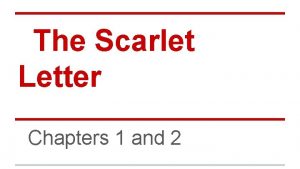Scarlet Letter Lecture Chapters 16 19 Hester attempts






![Point of View re- Dimmesdale Chapter 16 p 164 [Hester] beheld the minister advancing Point of View re- Dimmesdale Chapter 16 p 164 [Hester] beheld the minister advancing](https://slidetodoc.com/presentation_image/0da2f9137ccf51950acc3c02e6e03485/image-7.jpg)






![Dimmesdale thinking about himself Chapter 17 p 166 “Hast thou [found peace]? ” she Dimmesdale thinking about himself Chapter 17 p 166 “Hast thou [found peace]? ” she](https://slidetodoc.com/presentation_image/0da2f9137ccf51950acc3c02e6e03485/image-14.jpg)
















![From Chapter 16 p 163 -164 The child [Pearl] went singing away, following up From Chapter 16 p 163 -164 The child [Pearl] went singing away, following up](https://slidetodoc.com/presentation_image/0da2f9137ccf51950acc3c02e6e03485/image-31.jpg)
- Slides: 31

Scarlet Letter Lecture Chapters 16 - 19 Hester attempts to take charge in the Famous Forest Scenes

Symbolism The scene of Hester and Dimmesdale in the forest is full of symbolism; • The ‘primeval Forest’ – symbolizing the moral wilderness of darkness, evil, and sin; • The cold and gloominess of the forest symbolize Hester’s mood and state of mind; • The symbols of nature , natural law are juxtaposed with the more artificial laws of Puritan society • ‘the scrofula from the troubles of their ancestors’ p 161 • The symbolic use of Light and Dark – a constant motif throughout the Novel as a whole;

Examples of Symbols • • Gray expanse of cloud p 160 Flickering sunshine Sportive sunlight The light lingered about the lonely child The sunshine vanished Black reality The dismal verge of the forest This intense seclusion of the forest

Dimmesdale’s Dilemma By chapter 17 – we learn more about the progressive plot development of his dilemma that of being a man of God, and his earthly sin; • Nina Baym [page xx] - ‘In this dilemma, he is driven to secret self-punishments, to halfconfessions which fool everybody except himself, to hypocrisy and self-loathing. ’ • This is already strikingly becoming apparent in earlier chapters, notably Chapter 11

Chapter 16 A Forest Walk • Hester, after several days of trying to meet with and tell Dimmesdale – she learns that he will be returning from a visit to Apostle Eliot, an Indian convert, through the forest; • Hester wishes to speak with Dimmesdale in the openness of Nature; • Though she is aware of the symbolical parallel between the natural wilderness of the forest and the moral wilderness;

The Symbolism of the Forest • The narrator represents the forest as a symbol in a number of different ways – • It is the dwelling place of the Black Man – a wilderness where the Devil and the Indians roam; • Those who venture out into the forest at night are believed to be meeting with the Devil; • The forest symbolically contrasts with the strictness of the Puritan settlement; • The forest thus symbolizes openness, freedom, and naturalness;
![Point of View re Dimmesdale Chapter 16 p 164 Hester beheld the minister advancing Point of View re- Dimmesdale Chapter 16 p 164 [Hester] beheld the minister advancing](https://slidetodoc.com/presentation_image/0da2f9137ccf51950acc3c02e6e03485/image-7.jpg)
Point of View re- Dimmesdale Chapter 16 p 164 [Hester] beheld the minister advancing along the path, entirely alone, and leaning on a staff… [Dimmesdale] looked haggard and feeble, and betrayed a nerveless despondency in his air. Here it was woefully visible, in this intense seclusion of the forest, which of itself would have been a heavy trial to the spirits. To Hester’s eye, the Reverend Mr. Dimmesdale exhibited no symptom of positive and vivacious suffering, except that, as little Pearl remarked, he kept his hand over his heart.

Chapter 17 The Pastor and His Parishioner • Hester and Dimmesdale’s meeting in the forest is strikingly awkward at first; • Critical significance of the setting – that of the forest - for their meeting; • Up to this point neither of them have found peace in their lives - “hast thou found peace? ” • Dimmesdale reflects on his continued hypocrisy vis-à-vis his religious faith and profession; • Dimmesdale is furious with Hester upon finding out she has all along kept hidden from him Chillingworth’s true identity;

Commentary • Hester recognizes the depth of evil she has allowed, and tries to explain her deception; • She Hester concludes – “But a lie is never good, even though death threatens on the other side. ” Chapter 17 p 169 • The narrator reveals his philosophy on punishment and forgiveness – that Chillingworth’s deliberate, calculated acts of malice are far worse than sins of passion

Commentary • The Dimmesdale-Hester encounter in the Forest reveals the reawakening of their dormant love; • It also reveals much about both their characters, and their futures; • Hester comes across as strong; and she is able to analyze their situation and make plans for the future; • She also demands that Dimmesdale be strong too and take control over his life; • Dimmesdale being weaker – he doubts he can do anything • The forest also functions as a symbol of escape

Nina Baym comments on page xviii Interpretative Commentary • Dimmesdale is a character who is apparently concerned to do good but is too deeply self-immersed to connect with others; • We see in him no sign of love for Hester or Pearl; • He leaves Hester to support herself and the child despite the extremely limited possibilities for female self-sufficiency in Puritan Boston;

Literary Critic - Nina Baym cont • When he thinks of the mother and child, Dimmesdale seems mainly to fear that some physical resemblance between Pearl and himself will reveal his sin to the world; • In the famous forest scene Chapters 17 -19, Dimmesdale’s conversation is all about his own sufferings and trials; he expects Hester to be fully involved in his problems, but has no thought of hers;

Critic - Nina Baym cont • Dimmesdale, almost like a stereotypical woman • Manipulates her into suggesting that he run away, and then into volunteering to accompany him; • Always - the emphasis is on what is best for him;
![Dimmesdale thinking about himself Chapter 17 p 166 Hast thou found peace she Dimmesdale thinking about himself Chapter 17 p 166 “Hast thou [found peace]? ” she](https://slidetodoc.com/presentation_image/0da2f9137ccf51950acc3c02e6e03485/image-14.jpg)
Dimmesdale thinking about himself Chapter 17 p 166 “Hast thou [found peace]? ” she asked. “None!—nothing but despair!” he answered. “What else could I look for, being what I am, and leading such a life as mine? Were I an atheist, —a man devoid of conscience, —a wretch with coarse and brutal instincts, —I might have found peace, long ere now. Nay, I never should have lost it! But, as matters stand with my soul, whatever of good capacity there originally was in me, all of God’s gifts that were the choicest have become the minister’s of spiritual torment. Hester, I am most miserable. ”

Dimmesdale to Hester p 166 -167 “The people reverence thee, ” said Hester. “And surely thou workest good among them! Doth this bring thee comfort? ” “More misery, Hester—only the more misery!” answered the clergyman, with a bitter smile. “As concerns the good which I may appear to do, I have no faith in it. It must needs be a delusion. What can a ruined soul, like mine, effect towards the redemption of other souls? Or a polluted soul towards their purification? ”

“You wrong yourself in this, ” said Hester gently - p 167 “No, Hester, no!” replied the clergyman. “There is no substance in it! It is cold and dead, and can do nothing for me! Of penance I have had enough! Of penitence there has been none! Else, I should long ago have thrown off these garments of mock holiness, and have shown myself to mankind as they will see me at the judgment-seat. Happy are you, Hester, that wear the scarlet letter upon your bosom! Mine burns in secret! Thou little knowst what a relief it is, after the torment of a seven years’ cheat, to look into an eye that recognizes me for I am.

An Aside - Digression What of some students of Literature – with their - • Garments of Mock Studiousness?

Dimmesdale and Hester p 167 -168 “Had I one friend—or were it my worst enemy!— to whom, when sickened with the praises of all other men I could daily betake myself, and be known as the vilest of all sinners, methinks my soul might keep itself alive thereby. ” Again she hesitated, but brought out the words with an effort. —“Thou hast long had such an enemy and dwellest with him under the same roof!” The minister started to his feet, gasping for breadth, and clutching at his heart as if he would have torn it out of his bosom.

Chapter 18 A Flood of Sunshine • The narrator explains the source of Hester’s boldness and forwardness; • Having been ostracized by the Boston Puritan community – Hester has learned to think for herself, free from their strict boundaries and conventions; • In contrast, Dimmesdale as a Puritan pastor – remains a representative of their system, and therefore is bound all the more by its strict religious and moral ideology;

Key Passage from Chapter 18 p 174 Hester’s Enumeration of Criticisms Her intellect and her heart had their home, as it were, in desert places. For years past she had looked from this estranged point of view at human institutions, and whatever priests or legislators had established; criticizing all with hardly more reverence than the Indian would feel for the clerical band, the judicial robe, the pillory, the gallows, the fireside, or the church. The tendency of her fate and fortunes had been to set her free. The scarlet letter was her passport into regions where other women dared not tread. Shame, Despair, Solitude! These had been her teachers, —stern and wild ones, — and they had made her strong, but taught her much amiss.

Symbolism of Critically Significant Actions • Dimmesdale taking courage from Hester’s strength agrees to leave Puritan Boston with Hester; • They both feel a resurgence of hope; • Hester’s impulsive action of tearing off the scarlet letter and tossing it into the bushes; and by another impulsive action of taking off her ‘formal cap that confined her hair’ p 176 (Symbols of Puritan Law); • Nature favourably reflects on her passionate action by letting the sunshine burst forth; • These actions and events symbolize a resurgence of hope;

From Chapter 18 p 176 -177 ‘So speaking, she undid the clasp that fastened the scarlet letter, and, taking it from her bosom, threw it to a distance among the withered leaves. ’ ‘By another impulse, she took off the formal cap that confined her hair; and down it fell upon her shoulders, dark and rich…’ ‘All at once, as with a sudden smile of heaven, forth burst the sunshine, pouring a very flood into the obscure forest, gladdening each green leaf, transmuting the yellow fallen ones to gold, and gleaming adown the gray trunks of the solemn trees. ’

From Chapter 18 p 177 Such was the sympathy of Nature—that wild, heathen Nature of the forest, never subjugated by human law, nor illumined by higher truth— with the bliss of these two spirits! Love, whether newly born, or aroused from deathlike slumber, must always create a sunshine, filling the heart so full of radiance, that it overflows upon the outward world. Had the forest still kept its gloom, it would have been bright in Hester’s eyes, and bright in Arthur Dimmesdale’s!

So in these chapters we see • A resurgence of hope; matters are looking up; • Hester is transformed from the downcast and forlorn woman of the earlier chapters • To her once again passionate, energized, and voluptuous self-identity;

Refer back to Chapter 13 p 142; Compare and Contrast with Chapter 18 All the light and graceful foliage of her character had been withered up by this red-hot brand, and long ago fallen away, leaving a bare and harsh outline… Even the attractiveness of her person had undergone a similar change. It might be partly owing to the studied austerity of her dress, and partly to the lack of demonstration in her manners. It was a sad transformation, too, that her rich and luxuriant hair had either been cut off , or was so completely hidden by a cap, that not a shining lock of it ever once gushed into the sunshine.

Amidst Hope - Dark Foreshadowing • The narrator however also calls our attention to the fact that the scarlet letter – tossed aside by Hester – falls short of being carried away by the little brook; • This symbolically foreshadows that Hester will not be rid of the stigma of the scarlet letter so easily as she had hoped; • Also Pearl’s fanciful meeting with a wolf – ‘offered his savage head to be petted by her hand’ p 178

Chapter 19 • In Chapter 19 - we see the foreshadowing noted at the end of Chapter 18 - is fulfilled • As Pearl refuses to accept her mother without the familiar scarlet letter; • Pearl insists her mother take up the symbol herself, and refuses to accept Dimmesdale’s kiss; • Allegorically, Pearl functions as their living conscience – reminding both of them of their situation, their responsibilities, and the impossibility of escaping their guilt;

• The symbolical significance of Pearl’s action of refusing to join Hester and Dimmesdale can be interpreted on multiple levels; But most significantly • If Pearl herself is the symbolic embodiment of the scarlet letter – then neither she or the scarlet letter itself can be easily tossed away; • Let us not forget - she symbolically functions as the living testament of their sin;

Chapter 19 p 186 Fusion of the Imaginary and Reality And now this fateful interview had come to a close. The dell was to be left a solitude among its dark, old trees, which, with their multitudinous tongues, would whisper long of what had passed there, and no mortal be wiser. And the melancholy brook would add this other tale to the mystery with which its little heart was already overburdened, and whereof it still kept up a murmuring babble, with not a whit more cheerfulness of tone than for ages heretofore.

Refer to Chapter 16 p 162 All these giant trees and boulders of granite seemed intent on making a mystery of the course of the small brook; fearing, perhaps, that, with its never-ceasing loquacity, it should whisper tales out of the heart of the old forest whence it flowed, or mirror its revelations on the smooth surface of a pool. Continually, indeed, as it stole onward, the streamlet kept up its babble, kind, quiet, soothing, but melancholy, like the voice of a young child that was spending its infancy without playfulness, and knew not how to be merry among sad acquaintance and events of sombre hue.
![From Chapter 16 p 163 164 The child Pearl went singing away following up From Chapter 16 p 163 -164 The child [Pearl] went singing away, following up](https://slidetodoc.com/presentation_image/0da2f9137ccf51950acc3c02e6e03485/image-31.jpg)
From Chapter 16 p 163 -164 The child [Pearl] went singing away, following up the current of the brook, and striving to mingle a more lightsome cadence with its melancholy voice. But the little stream would not be comforted, and still kept telling its unintelligible secret of some very mournful mystery that had happened —or making a prophetic lamentation about something that was yet to happen—within the verge of the dismal forest.
 Scarlet letter 11-12
Scarlet letter 11-12 Scarlet letter vocabulary chapters 1-4
Scarlet letter vocabulary chapters 1-4 Scarlet letter chapter 21 analysis
Scarlet letter chapter 21 analysis Scarlet letter chapter 23-24 summary
Scarlet letter chapter 23-24 summary Chapter 15 of the scarlet letter
Chapter 15 of the scarlet letter Scarlet letter chapter 11 and 12 summary
Scarlet letter chapter 11 and 12 summary 01:640:244 lecture notes - lecture 15: plat, idah, farad
01:640:244 lecture notes - lecture 15: plat, idah, farad Grass and root letters
Grass and root letters Scarlet letter symbols
Scarlet letter symbols Scarlet letter background
Scarlet letter background The scarlet letter chapter 17 summary
The scarlet letter chapter 17 summary Scarlet letter chapter 1-4 summary
Scarlet letter chapter 1-4 summary Chapter 5-6 scarlet letter
Chapter 5-6 scarlet letter Follow your arrow youtube
Follow your arrow youtube The scarlet letter chapter 16
The scarlet letter chapter 16 Is the scarlet letter italicized
Is the scarlet letter italicized Chapter 5-6 scarlet letter
Chapter 5-6 scarlet letter Steeple crowned hats
Steeple crowned hats Pen metaphors
Pen metaphors Alliteration in the scarlet letter
Alliteration in the scarlet letter Olivia sauer
Olivia sauer The scarlet letter chapter 4
The scarlet letter chapter 4 Personification in the scarlet letter
Personification in the scarlet letter Scarlet letter setting
Scarlet letter setting The scarlet letter summary chapter 7
The scarlet letter summary chapter 7 Scarlet letter chapter 11
Scarlet letter chapter 11 When do you use italics
When do you use italics Scarlet letter chapter 3
Scarlet letter chapter 3 Chapter 2 summary the scarlet letter
Chapter 2 summary the scarlet letter Scarlet letter vocabulary
Scarlet letter vocabulary The scarlet letter historical context
The scarlet letter historical context The scarlet letter allegory
The scarlet letter allegory
